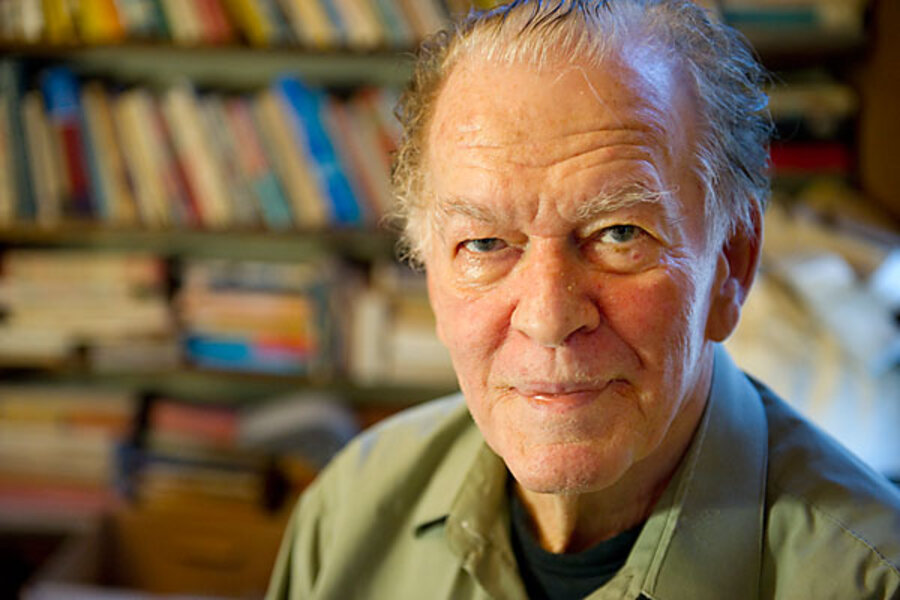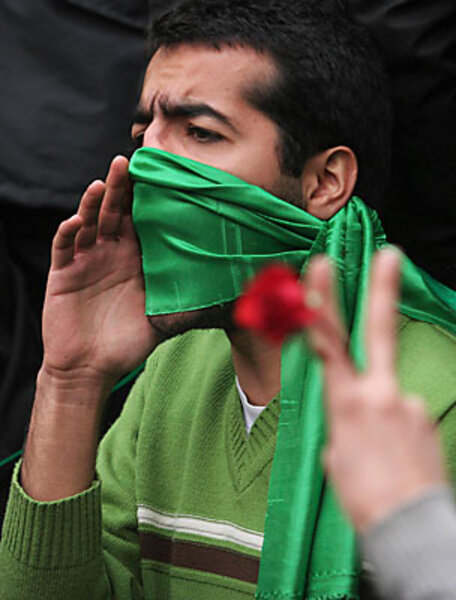Iran protesters: the Harvard professor behind their tactics
Loading...
| Istanbul, Turkey
After massive protests shook Iran this past summer, Iran singled out an obscure American political scientist in his 80s as a key figure behind the unrest.
Gene Sharp, a retired Harvard researcher, is considered the godfather of nonviolent resistance. Since the early 1970s, his work has served as the template for taking on authoritarian regimes from Burma to Belgrade. A list of his 198 methods for nonviolent action can be downloaded free of charge, along with his seminal work, “From Dictatorship to Democracy,” which has been translated by his Albert Einstein Institute into two dozen languages ranging from Azeri to Vietnamese.
Hailed as the manual by those who conducted people-power coups in Eastern Europe, its contents were no secret in Iran, where authorities have obsessed for years about their vulnerability to a “velvet revolution.” In fact, a few years ago they requested – and were sent – hard copies of Mr. Sharp’s works. Officials saw this summer’s unrest as the fruit of his strategies.
In a mass trial of some 100 key reformist figures this past August, Iranian prosecutors charged that postelection protests were “completely planned in advance and proceeded according to a timetable and the stages of a velvet coup [such] that more than 100 of the 198 events were executed in accordance with the instructions of Gene Sharp.”
Sharp does not take credit – nor accept blame – for the summer crisis that, in the words of Iran’s most powerful military commanders, brought the regime to the “edge of a downfall.” But Sharp’s ideas are clearly reflected in the continuing political unrest.
“We don’t take charge of movements,” says Sharp, who runs his nonprofit on a modest budget out of his Boston home. “We try to provide materials to enable the people on the scene, who know the scene better than we do, by far, to make those decisions and do those things.”
Protests by the reformists took a bloody turn this weekend, with at least 8 dead by Monday. Antigovernment demonstrators attacked police with stones for the first time and also burned a jeep, according to an eyewitness. The nephew of former presidential candidate Mir Hossein Mousavi was killed. A spokesman for Mr. Mousavi alleged that Seyd Ali Mousavi's killing was a targeted assassination. He said he was shot in the heart.
Farsi downloads of booklet soar
In June, as hundreds of thousands took to Iran’s streets and faced a violent crackdown, downloads of “From Dictatorship to Democracy” in Farsi spiked to 3,487 from just 79 the month before on Sharp’s website. Other sites hosting Sharp’s work reported a similar boost in demand.
“The great irony is that people actually weren’t focused on the velvet revolution option before the elections,” says Karim Sadjadpour, an Iran expert at the Carnegie Endowment for International Peace in Washington. “It’s only after the elections, when Iranians have come to the realization that they can’t change their political fate with the ballot box, that they’ve looked to more dramatic options.”
The momentous collapse of authoritarian rule, from Czechoslovakia in 1989 to Serbia, Georgia, Ukraine, and others, established a model for implementing Sharp’s tactics – one the Iranian authorities sought to avoid.
Authorities in Iran have closely examined past velvet revolutions, as well as Sharp’s books. A 2007 cartoon video created by Iranian intelligence portrayed Sharp as “the theoretician of civil disobedience and velvet revolutions” and “one of the CIA agents in charge of America’s infiltration into other countries.”
But Iranians have their own history of “improvised struggles” that predate his work, says Sharp: the 1905-06 constitutional revolution, and the 1979 Islamic revolution against the shah, during which “protesters were even putting flowers in the guns of the shah’s soldiers.”
Today, the stated aim of former presidential candidate Mir Hossein Mousavi and other key reformists in Iran is not to overthrow the Islamic system set up in 1979, which they themselves helped build. Instead, they seek to reverse what they say was a fraudulent election, and make pro-democracy reforms within the existing system.
Still, some reformist actions are vintage Sharp, from Mr. Mousavi’s refusal to negotiate or back down on demands about the election to strict nonviolence. Sharp says it’s “quite amazing” that the protests are continuing despite an extensive crackdown that left scores dead and subjected detainees to torture and rape.
While fewer are brave enough to come out in the streets today, Sharp says massive demonstrations are only one way to bring down a regime. A variety of methods can be used to undermine dictators, who “require the assistance of the people they rule.”
Aggravate regime’s weaknesses
“These regimes always present themselves as all-powerful – absolutely omnipotent, so that resistance becomes futile,” says Sharp. “But if you learn this regime has these five ... or 20 weaknesses – and you can deliberately aggravate those weaknesses – it weakens the regime. It helps it fall apart.”
Sharp’s ideas, adapted for Iran, are circulated by people such as Mohsen Sazegara, a founder of the ideological Revolutionary Guard who was arrested after becoming a reformist editor in the 1990s.
He now lives in Virginia, where he produces a daily 10-minute video to encourage nonviolent action, which he says reaches hundreds of thousands in Iran. He has read Sharp’s work closely.
Farsi translations of two of Sharp’s books can be downloaded from Mr. Sazegara’s website, which receives 2,000 e-mails a day – often including new tactics that he beams back into Iran in his videos.
“Iranians are an educated nation, especially the younger generation ... and I’m sure that many of them study the experience of nonviolent movements in other countries,” says Sazegara, who adds that the strategy of Mousavi’s Green Movement is strictly nonviolent. “We think if we make a mistake and go for violent actions, the regime [can be] more brutal than any violent opposition.”
But it can still be a dangerous business, even from thousands of miles away from Iran. Sazegara says he has received a number of death threats.
“If they kill me, so what? There will be thousands of Mohsen Sazegaras right now,” he says. “Every one of the young generation has read these books, and knows everything better than me.”






